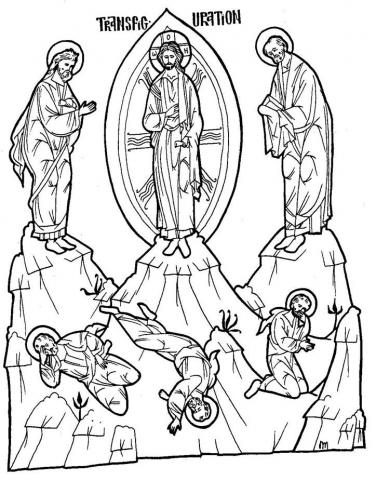Transfiguration
TRANSFIGURATION
Objectives:
 Students should be able to tell the story of the Transfiguration.
Students should be able to tell the story of the Transfiguration.- Students should be able to say the word “transfiguration” and know that it means “Change”.
- Students should be able to identify each character in the icon and his role in the story.
Possible Lesson Plan:
- Open with prayer.
- Scripture References: Luke 9:28-36, Matthew 17:1-13, Mark 9:1-9. Show the icon. Identify all the characters. What does “transfiguration” mean? Who was transfigured? In what way? Who did Jesus speak to? Which disciples came with Him?
- Discussion questions:
In Transfiguration, we see Jesus as both God and man. Is he 2 people? These are the questions of St. Ephraim: If Jesus were not human, who lay in the manger? If He were not God, whom did the angels glorify? If Jesus were not human, whom did Simeon take in his arms? If Jesus were not God, to whom did Simeon say, “Dismiss me in peace”? If Jesus were not human, whom did John baptize? If Jesus were not God, of whom did the Father speak? If Jesus were not human, who took Peter and James and John to the mount? If Jesus were not God, who spoke with Moses and Elijah?
We also see the Trinity at Transfiguration. At which feast was the triune nature of God (3 persons in 1 God) first revealed? (Theophany) Why doesn’t the Holy Spirit keep the same form on Mt. Tabor (What? luminous cloud) as at the Jordan (What? dove) or at Pentecost (What? tongues of fire)? It would be easier to recognize him if He would. Jesus always appears as a man since the Incarnation. But, the Spirit is not incarnate in the dove or the fire or the cloud; “He is everywhere and fills all things”.
The Transfiguration of our Lord occurred forty days before He was crucified. Remember some other important 40s in the Bible – 40 years in the wilderness for the children of Israel and 40 days in the wilderness being tempted for our Lord? With His Transfiguration, our Lord strengthened the faith of his disciples and helped prepare them for His coming crucifixion. Knowing His divinity, they could understand that His suffering was of His own free will.
- Historical Background: Review the Old Testament stories of Moses and Elijah. Why would God have chosen these two men for Jesus to speak to? What was their importance in the Jewish history? Both are considered to be forerunners of Jesus. Many people thought that John the Baptist was Elijah come back to life. How was John like Elijah? How was Jesus like Elijah? How was Jesus like Moses? But, even more important, Jesus was clearly greater than these great prophets, not one of them – an important understanding for the disciples.
- The Feast of theTransfiguration is celebrated on August 6. We bring fruit to church on the feast. Why? We are asking God to bless the harvest of fruit and the crops, which are just becoming ripe at this time. Clusters of grapes, ripe in Greece and in Palestine at about the time of the feast, are especially symbolic. What is made from grapes? (wine) Where does our Lord have us use wine each and every Liturgy? (the Eucharist) Why do the Russians bless apples at this time? (the climate is too cold for grapes!)
- Play a learning game: Guessing Game. Divide the class into 2 teams. Each team should have a captain as spokesperson. Both teams listen as the scorekeeper (teacher) reads a description of a character from the lesson (Jesus, Peter, James, John, Moses, Elijah, John the Baptist). Try for a long description, beginning with trivia (This person is a man. He has a beard…) and saving the critical facts for the end. The captain should stand when his team knows who it is. If right, that team gets the point.
- Make a Transfiguration Diorama. Use pipe-cleaners with a little clay on the bottom for figures. Draw your background on a piece of paper and glue into a shoebox or similar-size container. Green felt makes nice grass on the bottom. What are the figures carrying? Make clothing, if desired, of small bits of felt or cloth. Construction paper will do nicely for “props”.

- Close with prayer. Ask God to bless the fruit and crops now and every year.
